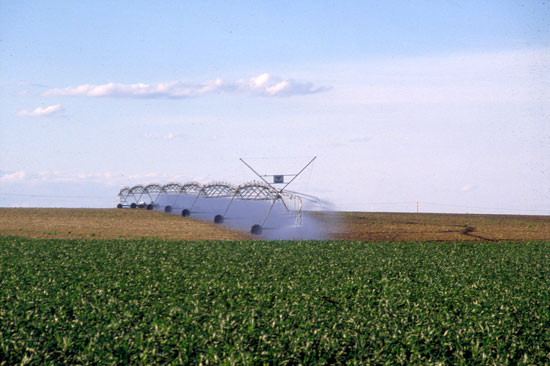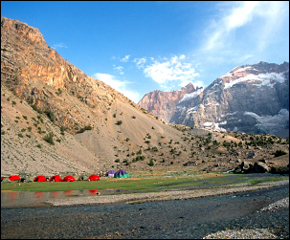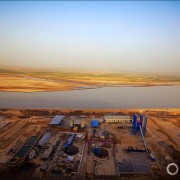With Locals at the Helm, Kansas Charts New Course for Groundwater Management
As they have been doing for decades, political leaders and water managers in Kansas are upending Western water law traditions that originated before the state was even part of the Union.

By Brett Walton
Circle of Blue
In the next few days, Kansas’s chief engineer will certify a bold new water plan for one of the state’s five groundwater management districts — a plan designed and supported by those who will be bound by its restrictions.
Farmers in a section of the Northwest Kansas Groundwater Management District (GMD4) have agreed to a self-imposed 20 percent reduction over the next five years in the amount of water they pull out of the renowned and shrinking Ogallala Aquifer. They will use less water now, so that the finite water supply lasts longer.
–Burke Griggs,
Kansas assistant attorney general
The law enabling this feat of mutual self-preservation was passed last year in a package of water-management bills signed by Governor Sam Brownback (R), former head of the Kansas Department of Agriculture and a former U.S. Senator. The other laws in the package allowed farmers more flexibility in how they use their water rights.
Across many politically conservative states in the nation’s heartland, old water management principles, though not thrown out, are being modified to protect the basic ingredient of an agricultural economy. Farmers in Colorado and Texas, too, are responding to shrinking aquifers by putting limits on water use.
In Kansas — long a leader in innovative practices — an ethic of conservation, restriction, and flexibility, at least regarding water, has taken hold and is being led at the grassroots.
“At the end of the day, we need local support. We’ve seen a shift in mindset from ‘use it or lose it’ to a culture of conservation,” Mary Geiger, spokesperson for the Kansas Department of Agriculture, told Circle of Blue. “Kansas is built on agriculture, and agriculture needs water. Farmers and ranchers want to pass their operation on to the next generation.”
Saving Water for Later
One of the people deeply involved in these negotiations is Wayne Bossert, who has led GMD4 for nearly four decades. His district is the guinea pig for the new law, which authorizes “local enhanced management areas,” or LEMAs.
Bossert told Circle of Blue that formal discussions with local stakeholders about water restrictions began nearly five years ago. They drew up the boundaries for the restricted area and set the pumping limits before presenting them to the state last year, after the law was passed.
Their plan targets a 256-square-kilometer (99-square-mile) section of land, primarily in Sheridan County. Farmers in the Sheridan LEMA will be granted 69 centimeters of water per hectare (11 inches per acre) per year over the next five years, a 20 percent reduction from current allotments. Farmers have the flexibility to use a little more one year and a little less the next, as long as they do not exceed 3.5 meters per hectare (55 inches per acre) total by 2017. Livestock operations and recreational users also take a hit, but a smaller one, since they use less water.
Irrigation sucks up 80 percent of the water used in Kansas, and 96 percent of that water comes from aquifers. Sheridan County was selected for a LEMA because the area had a higher-than-average groundwater decline compared to the rest of GMD4.
“There was generally a strong consensus of support — not unanimous, but a consensus,” Bossert said about the plan, adding that the governor’s decision to champion the program was essential to getting the authorizing law through the legislature.
Confident Farmers
Burke Griggs helped write the statute when he worked at the Division of Water Resources. Now, an assistant attorney general for the state of Kansas, Griggs told Circle of Blue that the LEMA law strikes a balance between state authority and local control.
In the past, farmers could call on the chief engineer to administer water rights based on the priority system, in which older users are protected and junior claims are cut off. That course of action, Griggs explained, could enrage neighbors and ripple destructively through the local economy, if pumping were cut off completely. The result, he said, “was economic paralysis” and unchecked declines in the water table.
–Bill Golden, agricultural economist
Kansas State University
The LEMA law, however, shifts the power balance. Unlike an earlier law, the chief engineer can only approve, reject, or send back a LEMA management plan for revisions; he cannot make changes himself.
“It deals with the problem of inaction by locals, who want to manage their resource, but who are concerned that a central authority can come in and adopt rules that don’t take notice of local economic conditions,” Griggs said.
As with any attempt to restrict water use, lawsuits are always possible. Bossert said the rumblings started the day that the process began, but have since gotten lighter and lighter.
“I haven’t heard anything recently,” he said.
One reason may be that farmers are feeling more confident and that the deprivation might not be as bad as feared.
“Producers can overcome the reductions, to a large extent, by adopting new technologies and changing their field-management practices,” said Bill Golden an agricultural economist at Kansas State University. Golden led a study that looked at the economic pain that might be caused by the water restrictions. He found little cause for concern.
“The regional economy probably benefits more than the producers, because the water stays around longer,” he told Circle of Blue.
State officials like Griggs, the assistant attorney general, hold similar views, noting that, although yields will decrease, so will overhead costs. In other words, farmers will spend less on diesel fuel to pump water and less on pesticides and fertilizers.
“I applaud the local stakeholders, who have enough confidence in their farming skills that they can profitably irrigate with an 11-inch allocation,” Griggs said. He paused, then laughed. “If they were worse farmers, they might need more water.”
An Experiment or a Blueprint?
For all its promise of water savings, the Sheridan LEMA is still an experiment.
“In 30 years, how many LEMAs do we have?” Griggs wondered. “Are there 80? Are there three? Do they cover a large block of land, or are they small?”
Other groundwater districts are paying attention and considering their own restrictions. In five years, the residents of the Sheridan LEMA will vote on extending the plan — only then will it be clear whether the trial is working.
“Unless this LEMA is renewed for a longer period,” Barfield wrote in his December 2012 order of decision, “then the work and cooperation of GMD4, the Kansas Geological Survey, and the Division of Water Resources will largely be wasted, and remembered as little more than a gesture.”
Brett writes about agriculture, energy, infrastructure, and the politics and economics of water in the United States. He also writes the Federal Water Tap, Circle of Blue’s weekly digest of U.S. government water news. He is the winner of two Society of Environmental Journalists reporting awards, one of the top honors in American environmental journalism: first place for explanatory reporting for a series on septic system pollution in the United States(2016) and third place for beat reporting in a small market (2014). He received the Sierra Club’s Distinguished Service Award in 2018. Brett lives in Seattle, where he hikes the mountains and bakes pies. Contact Brett Walton








Not a huge issue, but the 11 inch per acre restriction is a 20% reduction from the recent historical use within the LEMA – not from the “..current allotments..”, which to me implies the current water rights. This new allocation is a much higher percentage reduction of the water rights than 20%. Regardless, a nicely written piece.